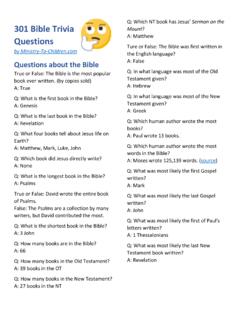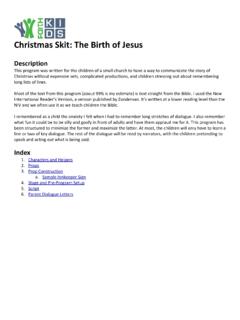Transcription of Standard Treatment Guidelines - World Health Organization
1 Republic of Ghana Standard Treatment Guidelines ministry of Health Sixth Edition, 2010. 2010 ministry of Health (GNDP) Ghana All rights reserved. No part of this publication may be reproduced, stored in a retrieval system, or transmitted in any form or by any means, electronic, mechanical, photocopying, recording and/or otherwise, without prior written permission of the ministry of Health , Ghana Essential Drugs List & National Formulary with Therapeutic Guidelines , 1st Edition, 1988. Essential Drugs List & National Formulary with Therapeutic Guidelines , 2nd Edition, 1993. Essential Drugs List & National Formulary with Therapeutic Guidelines , 3rd Edition, 1996. Standard Treatment Guidelines , 4th Edition, 2000. Standard Treatment Guidelines , 5th Edition, 2004.
2 Standard Treatment Guidelines , 6th Edition, 2010. ISBN 978-9988-1-2538-7. For all enquiries write to the publishers: Ghana National Drugs Programme (GNDP). ministry of Health P. O. Box MB-582, Accra, Ghana, West Africa Tel: (0)30 2661 670/1. Fax: (0)30 2664 309. E-mail: Website: Legal Disclaimer Care has been taken to confirm the accuracy of the information presented and to describe generally accepted practices. However, the authors, editors and publishers are not responsible for errors and omissions or any consequences from application of the information in this booklet and make no warranty, expressed or implied, with respect to the content of the publication. Printed by Yamens Press. Ltd. Accra, Ghana, West Africa. Tel: (0)30 2223 222.
3 Materials Development Consultant: Abbey P. O. Box AN 5116, Accra, Ghana, West Africa. Tel: (0)30 2304 211 / (0)30 2313 843. Designed by Logical Designs Tel: (0)30 2251 626, (0)244 215 903. E-mail: Cover design by Robert Dussey Tel: (0)244 843 245. E-mail: i LIST OF TABLES. Table 2-1: Assessment of the degree of dehydration in children with diarrhoea Table 2-2: Treatment by Fluid therapy- Plan A. Table 2-3: Treatment by Fluid therapy- Plan B. Table 2-4: Treatment by Fluid therapy- Plan C. Table 2-5: Helicobacter pylori Eradication Therapy Table 5-1: Pain Management in the Sickle Cell Patient Table 6-1: Schedule for Immunization for children Table 8-1: Antihypertensive Treatment by Drug Class Table 8-2: New York Heart Association functional Classification for Heart Failure Table 10-1: Drug Treatment of Seizures Table 10-2: Guidelines for the Management of the Unconscious Patient Table 12-1: Guidelines for the Treatment of Itching of specific causes Table 13-1: Regime for managing Diabetic Ketoacidosis in Adults Table 13-2: Regime for managing diabetic Ketoacidosis in children Table 13-3: Example of Sliding Scale Chart Table 15-1: Misoprostol Dosages for Reproductive Health Table 16-1.
4 Classification for Acute Kidney Injury, based on modification of RIFLE criteria Table 16-2 : Causes of Male Infertility Table 16-3: Symptoms and Signs of Urinary Tract Calculi Table 16-4: Distinguishing between Torsion and Epididymoorchitis Table 19-1: Guidelines for the Treatment of the Patient with Fever Table 19-2: Empirical Antibiotic Therapy for suspected Bacterial Meningitis in Adults Table 19-3: Artesunate + Amodiaquine Co-Blistered Tablets (Regimen for once daily dosing). Table 19-4: Artesunate and Amodiaquine Co-Blistered Tablets (Regimen for twice daily dosing). Table 19-5: Artesunate and Amodiaquine Fixed Dose Combination. ( Standard Regimen, using the 3 available dosing strengths). Table 19-6: Artemether and Lumefantrine (Recommended Dosing Regimen).
5 Table 19-7: Dihydroartemisinin and Piperaquine (Recommended Dosing Regimen). Table 19-8: Dosing Regimen for Quinine IM Injection in young children Table 19-9: Rectal Artesunate (Pre-Referral Treatment in children ). Table 19-10:Rectal Artesunate (Pre-Referral Treatment in Adults). Table 19-11:Pharmacological Treatment of Worm Infestations Table 20-1: Dose of Vitamin A for Xerophthalmia Table 20-2: Characterising Acute Red Eye with no history of Injury Table 20-3: Summary of the Common Causes and Management of Conjunctivitis Table 23-1: Points of distinction between Inflammatory and Mechanical Back Pain Table 24-1: Indication for use of Rabies Immunoglobulin and Rabies vaccine Table 26-1: Choice of Antibiotic for Prophylaxis vii PREFACE.
6 Standard Treatment Guidelines (STG) are systematically developed statements that assist prescribers in deciding on appropriate treatments for specific clinical problems. They usually reflect the consensus on the optimal Treatment options within a Health system and aim at beneficially influencing prescribing behaviour at all levels of care. Health systems, particularly in developing countries, are faced with growing Health needs on one hand and limited resources on the other. Policy makers at various levels are therefore engaged in designing cost-effective Health interventions that ensure accessible and affordable quality care for all, in particular the poor and vulnerable groups. Inappropriate prescribing is one of the manifestations of irrational medication use behaviour.
7 It occurs when medicines are not prescribed in accordance with Guidelines that are based on scientific evidence to ensure safe, effective, and economic use. STGs provide the tool for Health care providers to give quality standardised care at affordable cost. For our growing National Health Insurance Scheme, a Standard Treatment guideline is seen as a cost containment tool to ensure that inefficiencies, fraud and poly-pharmacy, often associated with Health Insurance Schemes, are minimised. Regular, objective and transparent reviews of STGs are very important because the development process is a continual effort and not limited to a one-time production. This process includes gaining acceptance of the concept and preparing the text for wide consultation and consensus building.
8 This is to ensure that users identify with and collectively own the process of development. This document is the sixth edition of the ministry of Health 's officially approved prescribers' and dispensers' guide for all levels of healthcare. Great effort has been put into aligning the prevailing Health insurance benefits package to this edition is also available on compact disk and can be accessed on the internet at The ministry of Health is particularly grateful to its development partners for their continuous support for the Health sector. I am confident that all users of this document would find this edition very useful. Dr. Benjamin Kunbuor Hon. Minister for Health May, 2010. viii IMPORTANT CONTACTS. PHARMACOVIGILANCE UNIT, FOOD AND DRUGS BOARD.
9 Adverse drug reactions: Please report any adverse drug reactions to the Pharmacovigilance Unit of the Food and Drugs Board (FDB). Telephone number: 030- 2229 621, 030-2233 200, 030-2235 100, 030-2225 502. Fax number: 030- 2229 794. Website: NATIONAL AIDS CONTROL PROGRAMME (NACP). Telephone number: 030-2662 691. NATIONAL AMBULANCE SERVICES. Telephone number: 030-2684 201, 030-2684 251, 030-2684 259. NATIONAL DRUG INFORMATION RESOURCE CENTRE. Telephone number: 030-2678 557, 030-2678 559. Fax number: 030-2678 557. Website: NATIONAL POISONS CONTROL CENTRE. Telephone number: 030-2238 636, 030-2243 552. NATIONAL BURULI ULCER CONTROL PROGRAMME. Telephone number: 030-2686 337. Fax number: 030-2686 336. Website: GHANA POLICE SERVICE. Telephone number: 191, 999, 027-7522 288.
10 Website: Comments and suggestions should be sent to: The Programme Manager Ghana National Drugs Programme ministry of Health Box MB-582, Accra, Ghana Telephone number: (0) 30 2661 670/1. Fax number: (0) 30 2664 309. E-mail: Website: ix ACKNOWLEDGEMENT. The review of the Standard Treatment Guidelines 2010 by the ministry of Health / Ghana Health service and its agencies has been successfully completed as a result of the recommendations and contributions received from: MOH/GHS/School of Medicine and Pharmacy Executives Dr. B. Kunbuor Hon. Minister of Health Dr. Elias K. Sory Director General, Ghana Health Service (GHS). Dr. Sylvester D. Anemana Ag. Chief Director, MOH. Mr. James Ohemeng Kyei Chief Pharmacist, GHS/MOH. Mr. George Dakpalah Director, Policy Planning Monitoring and Evaluation (PPME), MOH.












